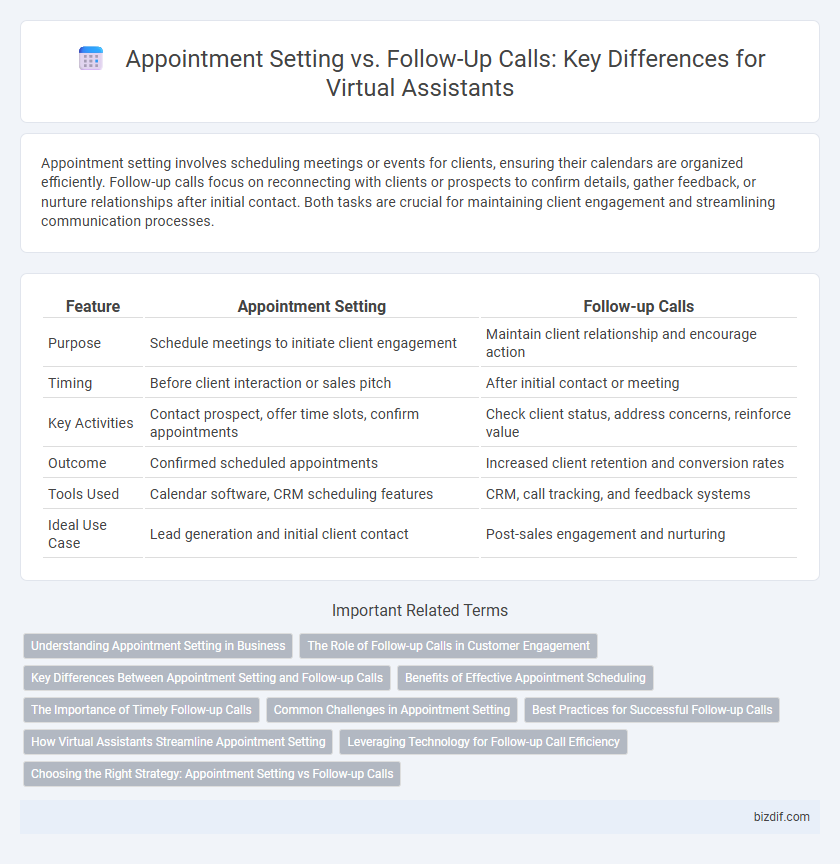Appointment setting involves scheduling meetings or events for clients, ensuring their calendars are organized efficiently. Follow-up calls focus on reconnecting with clients or prospects to confirm details, gather feedback, or nurture relationships after initial contact. Both tasks are crucial for maintaining client engagement and streamlining communication processes.
Table of Comparison
| Feature | Appointment Setting | Follow-up Calls |
|---|---|---|
| Purpose | Schedule meetings to initiate client engagement | Maintain client relationship and encourage action |
| Timing | Before client interaction or sales pitch | After initial contact or meeting |
| Key Activities | Contact prospect, offer time slots, confirm appointments | Check client status, address concerns, reinforce value |
| Outcome | Confirmed scheduled appointments | Increased client retention and conversion rates |
| Tools Used | Calendar software, CRM scheduling features | CRM, call tracking, and feedback systems |
| Ideal Use Case | Lead generation and initial client contact | Post-sales engagement and nurturing |
Understanding Appointment Setting in Business
Appointment setting in business involves scheduling meetings between potential clients and sales representatives, ensuring efficient time management and lead qualification. It streamlines the sales process by securing committed prospects, increasing conversion rates and optimizing sales team productivity. Virtual assistants specializing in appointment setting use CRM tools and communication platforms to coordinate schedules and minimize no-shows.
The Role of Follow-up Calls in Customer Engagement
Follow-up calls play a crucial role in enhancing customer engagement by reinforcing the commitment made during appointment setting and addressing any concerns or questions post-interaction. These calls increase conversion rates by maintaining consistent communication, building trust, and ensuring customer satisfaction. Virtual assistants leverage follow-up calls to personalize interactions, gather feedback, and foster long-term client relationships, ultimately driving business growth.
Key Differences Between Appointment Setting and Follow-up Calls
Appointment setting involves proactively scheduling meetings with potential clients to initiate business opportunities, emphasizing lead qualification and calendar management. Follow-up calls focus on maintaining communication after initial contact, aiming to nurture relationships, confirm details, and address any concerns to move prospects further down the sales funnel. Distinct in purpose and timing, appointment setting drives new engagements while follow-up calls enhance client retention and conversion rates.
Benefits of Effective Appointment Scheduling
Effective appointment scheduling maximizes client engagement and ensures optimal use of time, reducing no-shows and cancellations. Timely and well-organized appointments enhance customer satisfaction and improve overall business efficiency. Automated scheduling tools offered by virtual assistants streamline the booking process, freeing up resources for strategic tasks.
The Importance of Timely Follow-up Calls
Timely follow-up calls significantly enhance client retention and conversion rates by reinforcing initial communications and addressing any unresolved concerns promptly. Virtual assistants skilled in appointment setting ensure seamless scheduling, while their ability to conduct prompt follow-up calls maintains engagement and builds trust with prospects. Efficient follow-up strategies reduce no-shows and support continuous relationship management, driving long-term business growth.
Common Challenges in Appointment Setting
Common challenges in appointment setting include difficulty reaching decision-makers, managing scheduling conflicts, and overcoming gatekeeper obstacles. Virtual assistants often encounter incomplete or inaccurate contact information, leading to wasted time and reduced efficiency. Ensuring timely follow-ups and clear communication are essential to improve conversion rates and client engagement.
Best Practices for Successful Follow-up Calls
Effective follow-up calls require timely communication, ideally within 24 to 48 hours after the initial appointment setting to reinforce engagement and clarify details. Personalizing the conversation by referencing prior discussions and addressing specific client needs significantly increases conversion rates and builds trust. Utilizing CRM tools to track call outcomes and schedule subsequent interactions ensures consistent follow-up and maximizes appointment success.
How Virtual Assistants Streamline Appointment Setting
Virtual assistants streamline appointment setting by automating scheduling processes, reducing human error, and ensuring timely calendar updates across multiple platforms. They efficiently manage time zones, send reminders, and handle cancellations, improving client engagement and minimizing no-shows. By integrating with CRM systems, virtual assistants provide seamless follow-up management, enhancing overall appointment coordination and customer satisfaction.
Leveraging Technology for Follow-up Call Efficiency
Leveraging technology enhances follow-up call efficiency by automating reminders and tracking client interactions, ensuring timely and personalized communication. Advanced CRM systems integrate appointment setting with follow-up workflows, boosting productivity and reducing missed opportunities. AI-powered virtual assistants streamline scheduling and follow-ups, optimizing both client engagement and operational efficiency.
Choosing the Right Strategy: Appointment Setting vs Follow-up Calls
Appointment setting targets securing new client meetings through proactive outreach, maximizing lead conversion by scheduling specific time slots. Follow-up calls focus on nurturing relationships and reinforcing interest post-initial contact, enhancing customer retention and increasing the likelihood of closing deals. Selecting the right strategy depends on business goals: appointment setting drives lead acquisition, while follow-up calls ensure ongoing engagement and higher long-term conversion rates.
Appointment Setting vs Follow-up Calls Infographic

 bizdif.com
bizdif.com